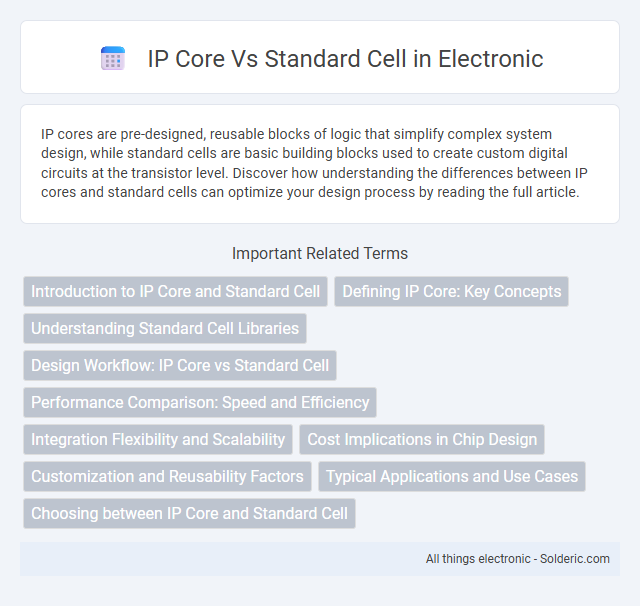IP cores are pre-designed, reusable blocks of logic that simplify complex system design, while standard cells are basic building blocks used to create custom digital circuits at the transistor level. Discover how understanding the differences between IP cores and standard cells can optimize your design process by reading the full article.
Comparison Table
| Aspect | IP Core | Standard Cell |
|---|---|---|
| Definition | Pre-designed, reusable functional blocks | Basic building blocks for ASIC designs |
| Design Effort | Low, ready-made modules | High, requires custom design |
| Integration Time | Fast integration | Longer integration and verification |
| Customization | Limited customization | Highly customizable |
| Performance | Optimized for general use | Optimized for specific use cases |
| Cost | Higher upfront licensing fees | Lower upfront cost, higher design cost |
| IP Reusability | High reusability across projects | Reusability depends on design effort |
| Examples | Processors, memory controllers | Logic gates, flip-flops |
Introduction to IP Core and Standard Cell
IP Core refers to pre-designed, reusable blocks of logic or functionality used in semiconductor design, accelerating time-to-market by integrating proven components. Standard Cell libraries consist of fundamental logic gates and flip-flops characterized for performance, power, and area, enabling custom digital circuit synthesis. Your choice between IP Core and Standard Cell impacts flexibility, design complexity, and development efficiency in chip creation.
Defining IP Core: Key Concepts
IP Core refers to a reusable unit of logic or functionality that can be integrated into semiconductor designs, often provided as pre-verified, modular blocks to accelerate development. Unlike standard cells, which are basic logic gates or transistors used to create custom circuits, IP Cores offer complex functions such as processors, memory controllers, or communication interfaces. Your ability to leverage IP Cores can significantly reduce design time and improve reliability by reusing proven technology within System-on-Chip (SoC) development.
Understanding Standard Cell Libraries
Standard cell libraries are collections of pre-designed, tested logic gates and flip-flops used to build integrated circuits efficiently, ensuring predictable timing and power characteristics. IP cores, in contrast, are complex, reusable functional blocks that integrate multiple standard cells to perform specific functions, simplifying the design process. Your choice between using standard cell libraries or IP cores depends on the level of design customization and integration required for your semiconductor project.
Design Workflow: IP Core vs Standard Cell
IP Core design workflow accelerates development by providing pre-verified, reusable blocks that integrate seamlessly into your SoC, reducing time-to-market and design complexity. Standard Cell methodology involves custom designing, characterizing, and placing individual logic gates, offering greater flexibility but requiring more extensive verification and longer design cycles. Choosing between IP Core and Standard Cell workflows depends on balancing design customization needs with project timelines and resource constraints.
Performance Comparison: Speed and Efficiency
IP cores offer optimized speed and efficiency tailored for specific functions, often resulting in faster development and reliable performance compared to standard cell designs. Standard cells provide greater design flexibility but may require more effort to achieve the same level of speed and power efficiency found in pre-verified IP cores. Your choice between IP core and standard cell impacts overall system performance, balancing customization against rapid deployment.
Integration Flexibility and Scalability
IP cores offer greater integration flexibility by providing pre-designed, reusable functional blocks that can be easily incorporated into various chip designs, enabling faster development cycles. Standard cells, consisting of predefined logic gates, allow more granular customization but require extensive manual effort for scaling and optimizing performance across different process nodes. Scalability is enhanced in IP cores through modular architecture, while standard cells demand meticulous layout adjustments to maintain efficiency in larger, more complex designs.
Cost Implications in Chip Design
IP Core integration can significantly reduce chip design costs by minimizing the need for custom development and accelerating time-to-market through reusable, pre-verified blocks. Standard Cells, while offering greater customization and potentially improved performance, often involve higher non-recurring engineering expenses and longer design cycles, increasing overall project costs. Your choice between IP Core and Standard Cell impacts both upfront investment and long-term scalability in chip manufacturing.
Customization and Reusability Factors
IP cores offer high reusability due to their pre-designed and verified nature, enabling rapid integration across multiple projects with minimal modification. Standard cells provide extensive customization as designers can tailor each cell's layout and functionality to meet specific performance, power, and area requirements. The choice between IP core and standard cell depends on project needs: IP cores prioritize time-to-market and ease of reuse, while standard cells emphasize design flexibility and optimization.
Typical Applications and Use Cases
IP Cores are commonly employed in FPGA designs, system-on-chip (SoC) integration, and complex digital logic blocks where reusable, pre-verified components accelerate development and reduce risk. Standard Cells are primarily used in custom ASIC designs for high-performance, low-power, and area-optimized applications requiring fine-grained customization at the transistor level. IP Cores suit rapid prototyping and feature-rich systems, while Standard Cells excel in manufacturing efficiency and tailored silicon implementation.
Choosing between IP Core and Standard Cell
Choosing between IP Core and Standard Cell depends on design complexity, time-to-market, and customization needs. IP Cores offer pre-verified, reusable blocks that accelerate development and reduce risk, ideal for common functions like processors or interfaces. Standard Cell design provides full control and flexibility for unique or highly optimized circuits but requires longer development time and higher expertise.
IP Core vs Standard Cell Infographic

 solderic.com
solderic.com